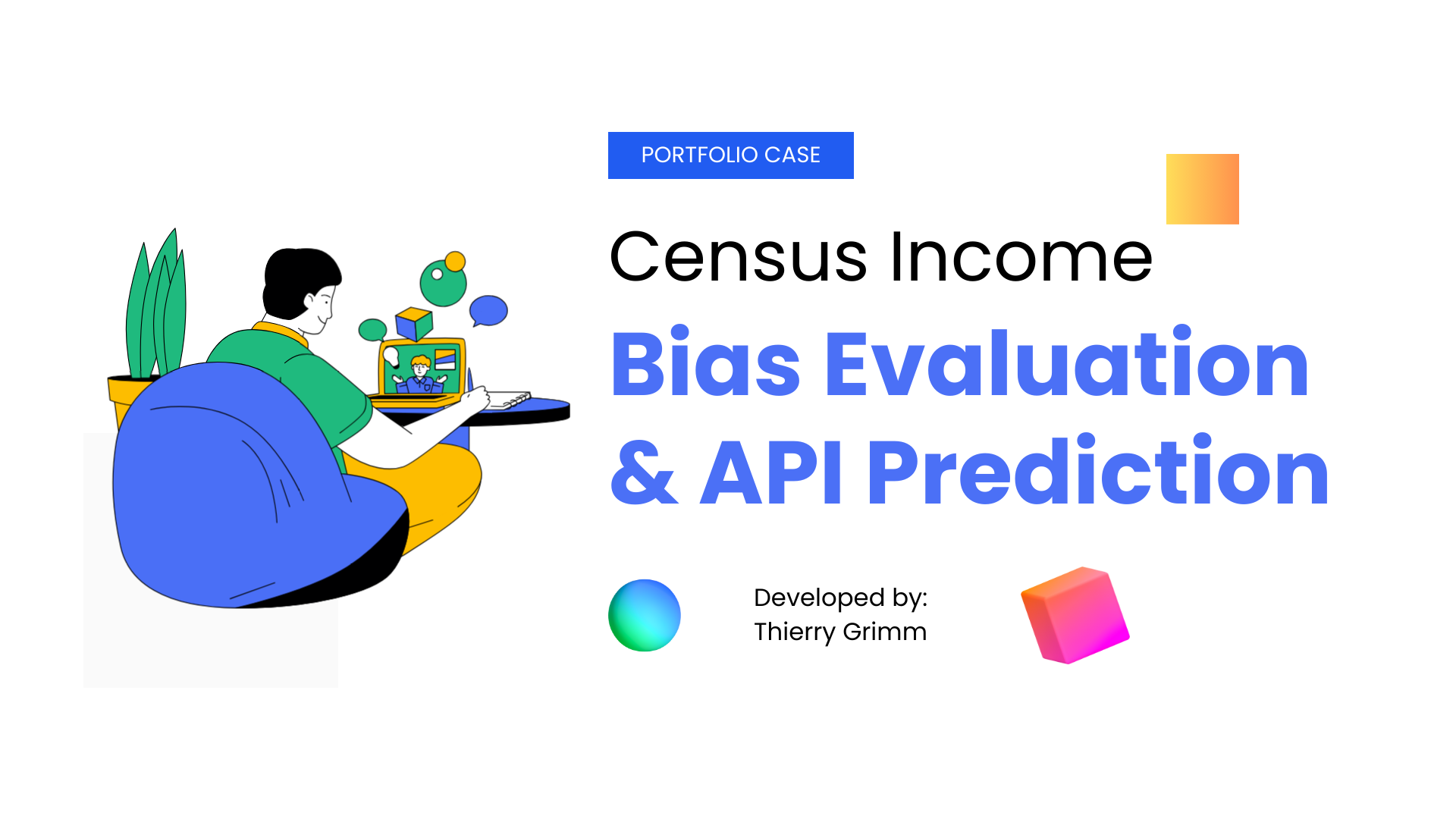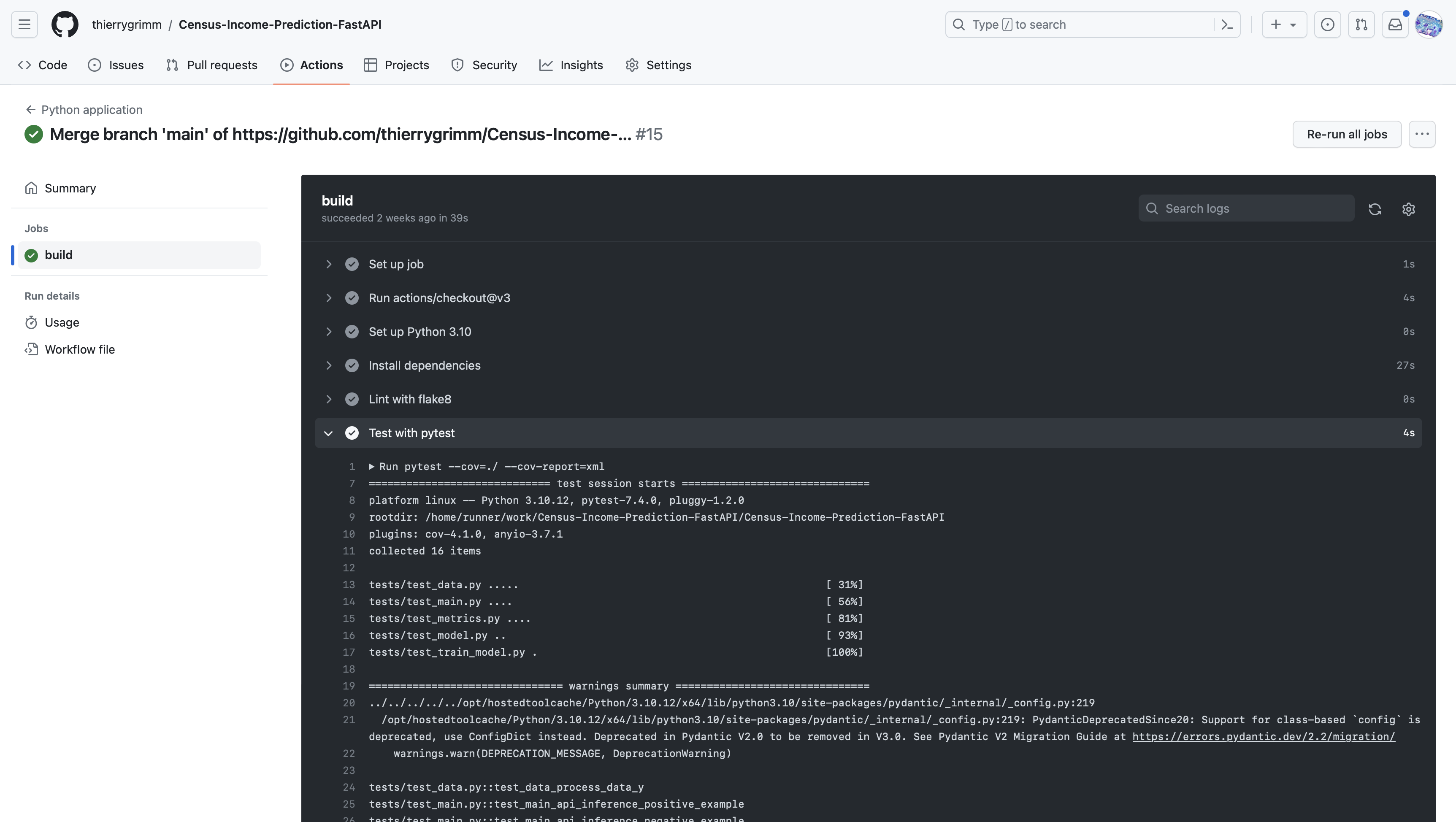Table of Contents
This project seeks to classify individuals into high salary (>50k) and low salary (<=50k) categories. It should mainly be used in fairness and bias-related endeavours and not in production.
The module follows coding (PEP8) and engineering best practices for implementing software (modular, documented and tested). It is built with unit tests which also log any errors, info and warning messages to a log file. The slice validation and the API unit tests were incorporated into a CI/CD framework using GitHub Actions. On a push it automatically runs flake8, pytest unit tests and codecov to ensure adequate code coverage.
🌟 Highlights:
- Project evaluated model performance on slices of the population to check for bias and fairness
- Utilized a CI/CD framework through GitHub Actions with unit tests, codecov and flake8
- FastAPI implements a RESTful API with Pydantic performing Type hinting
Data segregation was performed with a regular train-test-split with 80% used for training and 20% for testing
On the backend predictions are made using a Random Forest model.
To create a RESTful API that can be queried, FastAPI in combination with Pydantic for type hinting (ensuring proper
format for inputs) was used. Subsequently, the API was deployed as a web application, but the webserver is not publicly
accessible anymore.
The RESTful API has 2 different endpoints:
- (GET) at
/on the root giving a welcome message - (POST) at
/predictthat does model inference on the body with data in json format
F1 classification with a macro average of 0.79, 0.68 for the minority class, and 0.90 for the majority class.
When analyzing across data slices, model performance is higher for low-salary individuals.
File structure:
.
├── Images # Screenshots and images
├── data # Data
│ ├── census.csv # Entire dataset
│ ├── test.csv # Test split
│ └── train.csv # Train split
├── data.py # Data preprocessing pipeline
├── format.py # Type hinting for the API
├── main.py # FastAPI app endpoints
├── metrics.py # Generates metrics on slices of the data
├── model # Serialized model and objects
│ ├── LB.pkl # Label Binarizer
│ ├── OHE.pkl # Data OneHotEncoder
│ └── rfc_model.pkl # Random Forest Model
├── model.py # Model training helper functions
├── model_card.md # Details on model and data
├── query_api.py # Code to query the deployed API
├── * README.md # Project overview and instructions
├── requirements.txt # Python module requirements
├── slice_output.txt # Output of metrics.py
├── tests # Unit test suite
│ ├── test_data.py # Tests data processing
│ ├── test_main.py # Tests API
│ ├── test_metrics.py # Tests metrics prerequisites
│ ├── test_model.py # Tests predictions and model metrics
│ └── test_train_model.py # Tests training prerequisites
└── train_model.py # Model training pipeline
Make sure all module requirements are met or install them with:
python -m pip install -r requirements.txt
The main code for the API can be found in main.py.
To run the program execute the following command from the command line (CLI) :
uvicorn main:app --reload
By default, this will run the API on localhost on http://127.0.0.1:8000. Beware if this port was already occupied
it might be deployed on a different port or not be functional. By default, there is a greeting at the root by GET:
To send sample queries and test the API you can access the Swagger UI docs from your browser under:
http://127.0.0.1:8000/docs
This will render an overview of the different API endpoints including the /predict POST endpoint:
To query your deployed API edit the script query_api.py to include your API's host and port.
You can then query by running it in a terminal and should receive both the prediction and status code.
To run a Unit test suite, in the local file directory run:
pytest -vv
To run a specific Unit test, as for example for the main.py you may run:
pytest tests/test_main.py -vv
This project makes use of GitHub actions. Upon a push to main the test suite and other components such as flake8 or codecov will automatically be run:
This model is built on a dataset that contains sensitive attributes and (legally) protected groups such as race or sex. Furthermore, the dataset overall is imbalanced with a higher proportion of low income individuals. For high-income individuals the F1-score and especially the recall is worse. Also, the model performs slightly worse for women than for men. Another limitation of the model is the necessity for complete input data. Missing values are not handled off-the-gate.
It is recommended this model is strictly used for bias and fairness-related studies.
- The Census Income dataset is open source and was acquired from the UCI Machine Learning Repository. It is originally from: Kohavi,Ron. (1996). Census Income. UCI Machine Learning Repository. https://doi.org/10.24432/C5GP7S.
- The project is part of the ML DevOps Engineer Udacity Nanodegree.
Found a bug? Want more features? Find something missing in the documentation? Let me know! Please don't hesitate to file an issue and make a recommendation.
Census Income Prediction FastAPI - Evaluating bias and fairness in income prediction scenarios
The MIT License (MIT)
Copyright (c) 2023 Thierry Grimm
Permission is hereby granted, free of charge, to any person obtaining a copy
of this software ("Census Income Prediction FastAPI") and associated documentation
files (the "Software"), to deal in the Software without restriction, including without
limitation the rights to use, copy, modify, merge, publish, distribute, sublicense,
and/or sell copies of the Software, and to permit persons to whom the Software is
furnished to do so, subject to the following conditions:
The above copyright notice and this permission notice shall be included in
all copies or substantial portions of the Software.
THE SOFTWARE IS PROVIDED "AS IS", WITHOUT WARRANTY OF ANY KIND, EXPRESS OR
IMPLIED, INCLUDING BUT NOT LIMITED TO THE WARRANTIES OF MERCHANTABILITY,
FITNESS FOR A PARTICULAR PURPOSE AND NONINFRINGEMENT. IN NO EVENT SHALL THE
AUTHORS OR COPYRIGHT HOLDERS BE LIABLE FOR ANY CLAIM, DAMAGES OR OTHER
LIABILITY, WHETHER IN AN ACTION OF CONTRACT, TORT OR OTHERWISE, ARISING FROM,
OUT OF OR IN CONNECTION WITH THE SOFTWARE OR THE USE OR OTHER DEALINGS IN
THE SOFTWARE.












